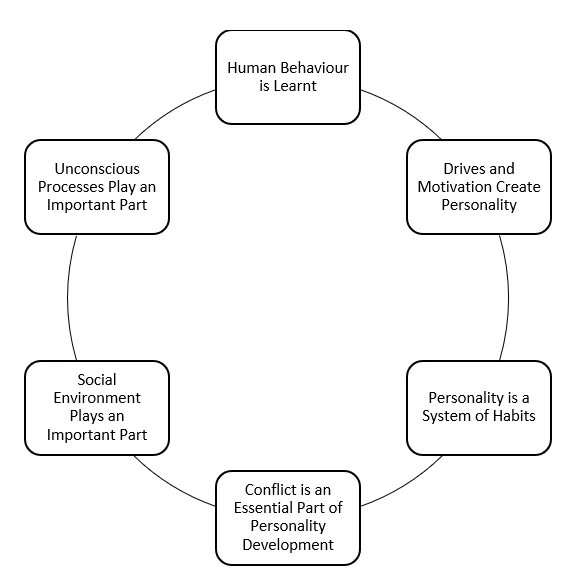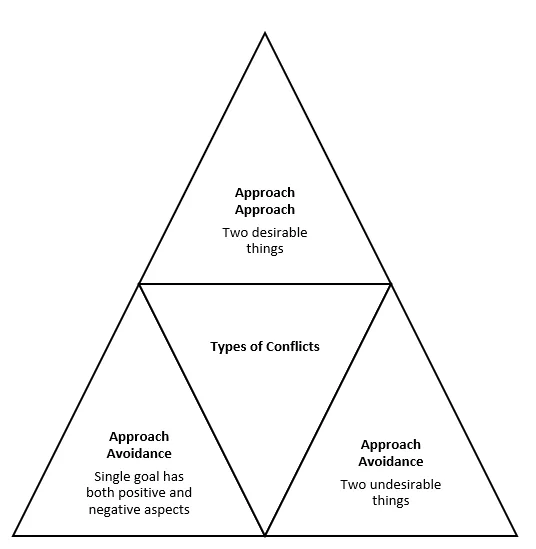Introduction
John Dollard and Neal Miller’s Stimulus-Response Theory of Personality is one of the foundational frameworks in psychology that merges behaviourist principles with psychoanalytic ideas. Developed in the mid-20th century, their theory proposes that personality is shaped through learning, primarily via stimulus-response associations.
This theory attempts to integrate two contrasting psychological perspectives- Freud’s psychoanalytic approach, which emphasizes internal, unconscious drives, and Pavlov’s behavioural approach, which focuses on conditioning through external stimuli.
By emphasizing reinforcement rather than Freud’s pleasure principle, Dollard and Miller’s theory offers a more concrete and testable explanation of how learning shapes personality. They viewed personality as a dynamic system of learned habits, each one formed through the interaction of stimuli, responses, drives, cues, and reinforcements. This framework provides a comprehensive view of how individuals develop unique patterns of behaviour and how these patterns constitute what we call personality.
Read More- What is Personality

Dollard and Miller’s Perspective of Personality
Dollard and Miller
John Dollard and Neal Miller came from different backgrounds but collaborated to create a theory that incorporated both social and psychological dimensions of behaviour. Dollard had a background in sociology and psychology, studying the effects of culture and society on individual behaviour. Miller, on the other hand, was trained in experimental psychology, specifically within the behaviourist tradition. His focus was on empirical research that could be used to study learning and personality in both humans and animals.
Their partnership emerged from their mutual interest in developing a scientific approach to understanding personality that could be empirically tested, unlike many of the Freudian ideas that were prominent at the time. Together, they synthesized insights from psychoanalysis, behaviourism, and social learning theory into a coherent model.
Read More- Psychoanalysis
Dynamics of Personality
Dollard and Miller’s Stimulus-Response (S-R) theory of personality offers a framework for understanding how our behaviours are shaped by the interaction of internal drives and external stimuli. This theory, which combines elements of psychoanalysis and behaviourism, emphasizes the role of learned habits and reinforcement in personality development.

Determinants of Personality
The dynamics of personality, according to Dollard and Miller, are determined by the ongoing interaction between drives, cues, responses, and reinforcement.
Drive
Drives are internal motivations that push us to act. They can be primary, such as biological drives like hunger, thirst, sleep, and sex, or secondary, such as psychological needs like the desire for approval, affection, or success. A drive represents an innate state of tension that seeks resolution by driving goal-directed behaviour aimed at reducing that tension. For instance, hunger (a primary drive) creates discomfort and motivates us to find food. However, drives do not specify exactly what behaviour to engage in—they merely push us toward fulfilling the need.
Cue
A cue is an external or internal stimulus that signals or triggers a particular behaviour. It guides the direction of goal-directed behaviour. For example, hunger pangs serve as an internal cue, pushing you to look for food to satisfy your hunger. Cues determine how and when you act in response to a drive. If you encounter a sandwich, the cue may lead you to eat it, whereas if you come across a drink, you might drink it instead. The specific behaviour depends on the cue that is available.
Response
A response is the behaviour triggered by the cue in order to reduce the drive. It is the action taken by the individual to reach the goal and alleviate the internal tension caused by the drive. For example, if you are hungry, the response might involve finding and eating food. Once the drive is reduced (hunger is satisfied), the response is reinforced, making it more likely that you’ll engage in the same behaviour in the future when faced with similar cues and drives.
Reinforcement
Reinforcement is the outcome that strengthens the link between the cue and the response. It occurs when a response leads to drive reduction, making the behaviour more likely to be repeated in the future. For example, if you eat a delicious meal and it satisfies your hunger, the positive experience reinforces the behaviour, making it more likely that you will seek out the same kind of meal next time you’re hungry. Reinforcement is central to learning in Dollard and Miller’s theory, as it solidifies the formation of habits by rewarding successful behaviour.
Dollard and Miller famously summarized the core of their theory by saying, “In order to learn, one must want something, notice something, do something, and get something.” These four elements—drive, cue, response, and reward—form the foundation of how personality is shaped through learned behaviours.
Habits- The Structure of Personality
Dollard and Miller’s theory posits that personality structure is essentially a collection of learned habits. A habit, in their terminology, refers to the learned association between a specific stimulus and a corresponding response. These habits, when reinforced over time, become relatively stable and consistent, forming the core structure of personality. For example- a person who has learned to associate social approval with self-esteem might develop the habit of seeking approval from others, which becomes a central component of their personality.
The strength and persistence of these habits are influenced by how often the response leads to reinforcement. If a behaviour is consistently rewarded, the habit becomes stronger, and the likelihood of engaging in that behaviour increases. Over time, these habits form a habit hierarchy, which determines the likelihood that a person will respond in a particular way to a given situation.
Habit Hierarchy
One of the most important concepts in Dollard and Miller’s theory is the habit hierarchy. This hierarchy represents the relative likelihood of different behaviours in response to a given cue or drive. In other words, the habit hierarchy ranks behaviours in terms of how likely they are to be performed when a specific drive is activated.
For example- imagine an individual who is experiencing hunger. They might have several potential responses in their habit hierarchy, such as eating a healthy meal, grabbing a quick snack, or ignoring the hunger and continuing to work. The behaviour at the top of the hierarchy—the one that is most likely to be performed—is the one that has been most strongly reinforced in the past.
The habit hierarchy is not fixed; it can change over time as new behaviours are learned and old behaviours are extinguished. For instance- if an individual begins to receive reinforcement for choosing healthy meals over snacks, the behaviour of eating healthy might move to the top of the habit hierarchy.
The concept of the habit hierarchy helps to explain why individuals might behave differently in similar situations. Each person’s hierarchy is shaped by their unique experiences and reinforcement history, leading to different patterns of behaviour.
The Development of Personality
Dollard and Miller believed that personality development is primarily a process of learning through experience. At birth, we are equipped with certain innate responses, such as reflexes. However, as we interact with our environment, we learn more complex behaviours that enable us to meet our needs and reduce our drives. Through the process of learning, we acquire new habits and modify existing ones, which shapes the development of our personality.
As children grow, they learn to associate specific responses with the reduction of drives. For instance, an infant may initially cry when hungry, but as they develop, they learn to communicate hunger in more effective ways, such as by asking for food. These learned behaviours are then reinforced through positive outcomes, leading to the formation of stable habits that guide future behaviour.
Innate Equipment
According to Dollard and Miller, humans are born with a set of innate needs or drives, such as hunger, thirst, and the need for warmth. These drives are essential for survival, and behaviour is motivated by the need to satisfy them. While the drives themselves are innate, the responses required to meet these needs are learned.
For example- all humans experience hunger, but the specific behaviours we engage in to satisfy hunger—such as seeking out food, preparing a meal, or deciding what to eat—are learned through experience. This distinction between innate drives and learned responses is a central component of Dollard and Miller’s theory.
Read More- Behaviourism
The Learning Process
The process of learning is central to Dollard and Miller’s theory of personality. Learning occurs when an individual engages in behaviour that reduces a drive, and this behaviour is reinforced by the satisfaction of the drive. Over time, certain responses become associated with specific cues and drives, leading to the formation of stable habits.
The learning process involves several key components-
- Drive- An internal state that motivates behaviour. Drives can be primary (biological, such as hunger or thirst) or secondary (learned, such as the desire for approval).
- Cue- An external or internal stimulus that signals the appropriate response to satisfy the drive. For example, hunger pangs (a cue) might lead an individual to seek out food.
- Response- The behaviour that is triggered by the cue and directed toward reducing the drive. This could involve finding food and eating to reduce hunger.
- Reinforcement- The outcome that strengthens the connection between the cue and the response. In this case, eating food reduces hunger, reinforcing the behaviour of seeking food in response to hunger cues.
Secondary Drive and the Learning Process
In addition to primary drives, Dollard and Miller proposed the concept of secondary drives. These are learned drives that develop through the process of conditioning. For example, a child might initially cry to reduce the primary drive of hunger. However, over time, the child may learn that crying also brings attention and comfort from caregivers, which leads to the development of a secondary drive for social approval.

Types of Drives
The process of learning secondary drives is crucial to personality development, as it enables individuals to respond to more complex social and emotional needs. As individuals experience reinforcement for behaviours that satisfy secondary drives, these behaviours become habitual and contribute to the structure of personality.
Higher Mental Processes
Dollard and Miller extended their theory to account for higher mental processes, such as thinking, problem-solving, and decision-making. These processes are also seen as learned responses to complex stimuli. For example, when faced with a problem, an individual may go through a series of learned steps to solve it, drawing on past experiences and learned strategies.
These higher mental processes play a critical role in managing conflicting drives. For instance, when an individual experiences a conflict between two drives—such as the desire to attend a social event versus the need to complete a work assignment—higher mental processes are used to evaluate the situation and make a decision.
The Social Context
Dollard and Miller placed significant emphasis on the role of the social context in shaping personality. Social interactions provide important cues and reinforcement for behaviour, which contribute to the development of secondary drives and habits. Cultural norms, family dynamics, and peer relationships all play a role in the learning process, guiding individuals toward certain behaviours and away from others.
For example- a child growing up in a culture that values academic achievement may learn to associate success in school with social approval and reinforcement. Over time, this leads to the development of a habit hierarchy that prioritizes academic success as a key aspect of the child’s personality.
Unconscious Processes
Although Dollard and Miller’s theory is grounded in behaviourism, they did not completely dismiss the role of unconscious processes. They argued that many of the habits and responses individuals develop occur without conscious awareness. These unconscious processes influence behaviour, especially when they involve unresolved conflicts or unmet drives.
For instance- an individual might develop an unconscious habit of avoiding social situations due to anxiety, even though they are not fully aware of the underlying reasons for their behaviour. In this sense, unconscious processes can shape personality by reinforcing certain patterns of behaviour.
Conflict
One of the key contributions of Dollard and Miller’s theory is their exploration of conflict. They identified three types of conflict that can arise when individuals face competing drives-
- Approach-Approach Conflict– This occurs when an individual must choose between two equally desirable options. For example, choosing between two appealing job offers may create a mild conflict, as both options are attractive.
- Avoidance-Avoidance Conflict– This occurs when an individual must choose between two equally undesirable options. For instance, a person might face a conflict between paying an expensive fine or attending a court hearing. This type of conflict tends to create more stress and discomfort than approach-approach conflict.
- Approach-Avoidance Conflict– This occurs when a single goal has both positive and negative aspects. For example, an individual might want to accept a job offer that provides a high salary but requires long hours and a stressful work environment. Approach-avoidance conflict creates ambivalence, as the individual is drawn toward the goal but also repelled by its negative aspects.

Types of Conflicts
Dollard and Miller emphasized that conflict plays a central role in shaping personality, as individuals must learn to navigate these competing drives and make decisions that reduce tension.
Current Research
Although Dollard and Miller’s theory has been modified over time, many of the principles they outlined continue to influence contemporary research. For example, the study of habit formation and the role of reinforcement in behaviour change remain active areas of research in psychology.
Research on neuroplasticity—the brain’s ability to reorganize itself by forming new neural connections—also supports many of the ideas proposed by Dollard and Miller. Neuroplasticity shows how repeated behaviours can lead to lasting changes in the brain, reinforcing the notion that habits are deeply ingrained patterns of behaviour.
In addition, current research on cognitive-behavioural therapy (CBT), a widely used approach in psychotherapy, draws heavily on the principles of reinforcement and learning outlined in Dollard and Miller’s theory. CBT focuses on helping individuals change maladaptive thought patterns and behaviours through a process of learning and reinforcement.
Wolpe and Seligman
Two notable psychologists who expanded on Dollard and Miller’s ideas are Joseph Wolpe and Martin Seligman. Wolpe developed the technique of systematic desensitization, which is based on the principles of stimulus-response learning. This technique is used to treat phobias by gradually exposing individuals to the feared stimulus while teaching them relaxation techniques, helping them unlearn their fear response.
Martin Seligman, known for his research on learned helplessness, also built on the principles of reinforcement and conditioning. Seligman’s work demonstrated how individuals can develop a sense of helplessness and depression when they experience repeated failures or lack of control over their environment. This concept of learned helplessness is closely related to the ideas of reinforcement and drive reduction in Dollard and Miller’s theory.
Critical Evaluation of the Approach
While Dollard and Miller’s Stimulus-Response Theory may no longer be the dominant model of personality in modern psychology, it remains highly influential. Their emphasis on the role of learning in personality development and the concept of habit hierarchies continue to inform contemporary theories of behaviour change and habit formation.
- Scientific Rigor– Unlike many psychoanalytic theories, which were difficult to test empirically, Dollard and Miller’s theory is based on clear, testable principles of learning and reinforcement. This has made it particularly useful in applied fields such as education and therapy.
- Oversimplification– one criticism of their theory is that it may oversimplify the complexity of human behaviour by reducing personality to a set of learned habits. Critics argue that human behaviour is influenced by a wide range of factors, including cognition, emotion, and genetics, that are not fully accounted for in Dollard and Miller’s model.
Despite these limitations, their theory remains a foundational framework in the study of personality, learning, and behaviour. It has provided valuable insights into how habits form and how personality develops through the ongoing interaction between drives, cues, responses, and reinforcement.
Conclusion
Dollard and Miller’s Stimulus-Response Theory of Personality provides a comprehensive framework for understanding how personality is shaped through learning. By emphasizing the role of reinforcement in habit formation, their theory offers a clear and testable explanation of how individuals develop unique patterns of behaviour. The concept of the habit hierarchy is particularly important, as it helps explain why individuals behave differently in similar situations based on their history of reinforcement.
While their theory has evolved and been modified over time, the principles they outlined continue to influence contemporary research and practice, particularly in fields such as behavioural therapy and education. The lasting impact of their work is a testament to the value of integrating behaviourist principles with a broader understanding of personality development.
Reference
Dollard, J., & Miller, N. E. (1950). Personality and Psychotherapy: An Analysis in Terms of Learning, Thinking, and Culture. New York: McGraw-Hill.
Pavlov, I. P. (1927). Conditioned Reflexes. London: Oxford University Press.
Dollard, J., & Miller, N. E. (1941). Social Learning and Imitation. New Haven, CT: Yale University Press.
Dollard, J., Doob, L. W., Miller, N. E., Mowrer, O. H., & Sears, R. R. (1939). Frustration and Aggression. New Haven, CT: Yale University Press.
Hall, C. S., Lindzey, G., & Campbell, J. B. (1998). Theories of Personality (4th ed.). New York: Wiley.
Miller, N. E., & Dollard, J. (1941). Social Learning and Imitation. New Haven, CT: Yale University Press.
Subscribe to Careershodh
Get the latest updates and insights.
Join 15,137 other subscribers!
Niwlikar, B. A. (2021, June 12). Stimulus-Response Theory of Personality- Discover the Insightful Ideas of 2 Thinkers. Careershodh. https://www.careershodh.com/stimulus-response-theory-of-personality/

I highly appreciate for such an in depth content of the information i wanted. Thank you very much. Such an insightful moment.